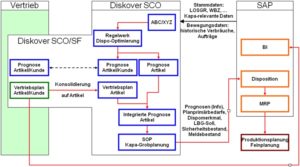From Andreas Capellmann
In the pharmaceutical and medical sector, one of the most important criteria that manufacturers have to take into account, in addition to flawless product quality, is a high level of readiness to deliver. Many companies are responding to this with higher security stocks, which of course ties up a lot of liquidity. Serag-Wiessner KG has mastered this balancing act with the help of the Advanced Planning and Scheduling (APS) software DISKOVER SCO and has not only been able to reduce stock levels, but also to improve delivery readiness even further.

When the order arrives at Serag-Wiessner, it has to go quickly. Suture material of various resorption levels, textile implants or irrigation and infusion solutions often have to be on site within 24 hours. Delays are not acceptable. For the manufacturers of such products, this is associated with increased stock levels, as they must remain able to deliver even in the event of fluctuations in demand and disruptions in the supply chain. To meet these requirements, stocks are held in the finished goods warehouse, which are dimensioned on the basis of ERP order proposals from planners and dispatchers.
In the case of Serag-Wiessner, this means that of the approximately 3,000 items that the company offers, around 1,500 items have to be kept in stock from the dispatch warehouse instead of being produced to order. This is the only way that the approximately 25,000 customers, which include hospitals, doctors in private practice and wholesalers in Germany and abroad, can receive the goods within the required delivery time.
As there is a lot of tied-up capital in these inventories and therefore also enormous savings potential, Serag-Wiessner had already tried several times to significantly reduce inventories using its own resources. However, without the hoped-for lasting success.
Efficient and sustainable solution sought
The management was therefore looking for a solution to optimize scheduling that would complement the ERP system more effectively and sustainably. The tool should be able to actively control target values and automatically display deviations from the target in order to make recommendations for action. In addition, the following targets had to be achieved or met: Delivery times of 24 to 48 hours and an average target delivery availability of 96%. In addition, the production orders and the associated set-up processes should be limited to 1,200 per month. All these framework conditions restrict the dispatcher when it comes to reducing stocks. Nevertheless, we have succeeded in reducing stocks sustainably. However, some preparatory work was necessary for this.
ERP system alone is not enough
At the beginning of the project, which was accompanied by the management consultancy for supply chain optimization Abels & Kemmner, the supply chain was put through its paces: How are the scheduling processes and logistics parameters such as range, readiness to deliver and stock turnover? The ERP system was also examined to determine whether all the tools are available to improve scheduling and reduce inventories effectively and permanently. It became clear that these goals could not be achieved with the ERP system alone. This is not surprising, as ERP systems are not specialized systems for forecasting and scheduling. You can perform these tasks with them with certain limitations, but the result is far from optimal. There are practically no automatic mechanisms for the continuous optimization of scheduling parameters.
Special tools for dispatchers in demand
Virtually all known ERP systems work exclusively with statistical methods that assume a normally distributed demand, such as mean value methods or exponential smoothing. In practice, however, normally distributed demand is practically never encountered. Rather, demand is subject to constant seasonal, cyclical or other fluctuations. As a result, calculations based on the assumption of normally distributed demand lead to systematically incorrect demand forecasts and inventory errors of up to 40%. In addition to the higher-level ERP system, you also need more precise special tools in order to be able to plan optimally. These precision tools for dispatchers are called Advanced Planning and Scheduling software, or APS software for short.
Differentiated simulations and high forecasting accuracy
In its search for the right APS tool, Serag-Wiessner found what it was looking for in SCT GmbH and its DISKOVER SCO supply chain optimization software. “We were particularly impressed by DISKOVER SCO’s extensive simulation functionalities and high forecasting accuracy,” explains Steffen Schwippl, Head of IT at Serag- Wiessner. “We have to maintain a very high level of delivery readiness for short delivery times. If you then drastically reduce safety stocks, as a planner you initially have a queasy feeling: ‘Can we always deliver on time? ‘ However, thanks to the highly differentiated design of DISKOVER, the planners quickly understand that the more differentiated calculations and case-oriented planning procedures lead to more precise results and that they achieve a better overall cost result through target-oriented planning.”
Convenient yet precise intervention in the supply chain
When the tool was introduced, differentiated simulations were first used to determine the correlations between delivery readiness, inventories and set-up costs. This made it possible to find out which settings for the aforementioned parameters can be used to achieve the target delivery readiness with the lowest possible stock levels. Based on this data, dispatchers can then intervene precisely in the supply chain and optimize it successfully. DISKOVER also takes into account differentiated sets of rules for the disposition of various product groups, which take into account the criteria of the ABC and XYZ indicators as well as the stock availability and market requirements of the various product groups. For example, different target delivery readiness levels or higher ranges can be defined for the lot sizes for low-value C-items. This is particularly interesting for companies such as Serag-Wiessner, whose product portfolio is very diverse, as it allows optimal planning for each product group.
Convenient supply chain optimization
DISKOVER SCO is characterized not only by its high precision and range of functions, but also by the fact that it is easy to handle in daily operation. This makes supply chain optimization particularly convenient. For example, users are actively informed of the current need for action and benefit from the consistent graphical visualization of demand forecasts and the corresponding scheduling suggestions. The effects of process or master data changes can be simulated interactively and intuitively and displayed graphically, which supports decision-making particularly efficiently.
Lower costs and effort for software solution
DISKOVER not only reduces the effort involved in operation. Thanks to the rental licence model and continuous delivery, DISKOVER also minimizes the costs and effort involved in purchasing, maintaining and operating the software solution. Instead of massive initial investments for runtime licenses, user companies only have to pay a much lower monthly fee for using DISKOVER SCO. And thanks to Continuous Delivery, all new software developments reach users in the shortest possible time. As direct user support, maintenance work and updates are carried out by the SCT service center, the customer’s IT department does not have to provide any specialist support for the system or its users. Hidden in-house costs, which are often forgotten when calculating alternative models, are therefore not incurred.
Higher delivery readiness with lower inventories
Since the introduction of DISKOVER SCO, the inventory situation at Serag-Wiessner has improved significantly. Excess stocks were eliminated and the total stock was reduced to around 65%. Despite the reduction in inventories, delivery readiness even improved by three percentage points to a continuous 96%. By reducing its inventory by 35%, Serag-Wiessner was able to free up corresponding liquidity reserves. And permanently.
The monthly cost savings achieved by using DISKOVER SCO through inventory reduction alone are far higher than the ongoing license costs for the software. After all, inventory reduction is not a one-off effect, but an ongoing one: by reducing stock levels, companies can save six-figure storage costs every year. Without optimization software, these annual costs would be recouped very quickly. And other positive effects achieved through the use of DISKVOER, such as reduced planning effort, improved delivery readiness and information capability, have not yet been taken into account.
Andreas Capellmann is Managing Director of SCT GmbH, a subsidiary of Abels & Kemmner GmbH.
Further information on this topic can be found here:
- DISKOVER website
- Case studies from the manufacturing industry
- Case studies from the wholesale trade

